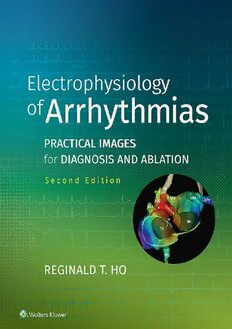
Electrophysiology of Arrhythmias: Practical Images for Diagnosis and Ablation PDF
Preview Electrophysiology of Arrhythmias: Practical Images for Diagnosis and Ablation
1 2 Senior Acquisitions Editor: Sharon Zinner Development Editor: Ashley Fischer Editorial Coordinator: Emily Buccieri Editorial Assistant: Nicole Dunn Production Project Manager: David Saltzberg Design Coordinator: Holly Reid McLaughlin Manufacturing Coordinator: Beth Welsh Prepress Vendor: Absolute Service, Inc. 2nd edition Copyright © 2020 Wolters Kluwer © 2010 by LIPPINCOTT WILLIAMS & WILKINS, a WOLTERS KLUWER business All rights reserved. This book is protected by copyright. No part of this book may be reproduced or transmitted in any form or by any means, including as photocopies or scanned-in or other electronic copies, or utilized by any information storage and retrieval system without written permission from the copyright owner, except for brief quotations embodied in critical articles and reviews. Materials appearing in this book prepared by individuals as part of their official duties as U.S. government employees are not covered by the above-mentioned copyright. To request permission, please contact Wolters Kluwer at Two Commerce Square, 2001 Market Street, Philadelphia, PA 19103, via email at [email protected], or via our website at shop.lww.com (products and services). 9 8 7 6 5 4 3 2 1 Printed in China Library of Congress Cataloging-in-Publication Data Names: Ho, Reginald T., author. Title: Electrophysiology of arrhythmias / Reginald T. Ho. 3 Description: Second edition. | Philadelphia : Wolters Kluwer, [2020] | Includes bibliographical references and index. Identifiers: LCCN 2019019636 | ISBN 9781975101107 Subjects: | MESH: Arrhythmias, Cardiac—diagnosis | Arrhythmias, Cardiac—surgery | Catheter Ablation | Electrophysiological Phenomena Classification: LCC RC685.A65 | NLM WG 330 | DDC 616.1/28—dc23 LC record available at https://lccn.loc.gov/2019019636 This work is provided “as is,” and the publisher disclaims any and all warranties, express or implied, including any warranties as to accuracy, comprehensiveness, or currency of the content of this work. This work is no substitute for individual patient assessment based on health care professionals’ examination of each patient and consideration of, among other things, age, weight, gender, current or prior medical conditions, medication history, laboratory data, and other factors unique to the patient. The publisher does not provide medical advice or guidance, and this work is merely a reference tool. Health care professionals, and not the publisher, are solely responsible for the use of this work including all medical judgments and for any resulting diagnosis and treatments. Given continuous, rapid advances in medical science and health information, independent professional verification of medical diagnoses, indications, appropriate pharmaceutical selections and dosages, and treatment options should be made, and health care professionals should consult a variety of sources. When prescribing medication, health care professionals are advised to consult the product information sheet (the manufacturer’s package insert) accompanying each drug to verify, among other things, conditions of use, warnings, and side effects, and identify any changes in dosage schedule or contraindications, particularly if the medication to be administered is new, infrequently used, or has a narrow therapeutic range. To the maximum extent permitted under applicable law, no responsibility is assumed by the publisher for any injury and/or damage to persons or property, as a 4 matter of products liability, negligence law or otherwise, or from any reference to or use by any person of this work. shop.lww.com 5 This book is dedicated to my family, especially to my wife, Maromi, and sons, Ethan and Jeremy, whose love, enduring patience, and encouragement made this book possible, and to my parents who have always been a source of love and inspiration to me. 6 Preface Since the first catheter recording of the human His bundle in 1960 and ablation in 1981, intracardiac electrophysiology has been the cornerstone of arrhythmia diagnosis and ablation. The ability to record electrical activity within the heart and observe its behavior to electrical stimulation has yielded valuable insights into the mechanisms and pathogenesis of arrhythmias. As a field where interpreting activation patterns, electrogram morphologies, and responses to pacing maneuvers are essential, electrophysiology is better understood through demonstration rather than description. This book is therefore purposefully designed to provide an understanding of arrhythmia diagnosis and ablation by using a comprehensive collection of intracardiac recordings; color-coded electro-anatomic maps; and fluoroscopy, intracardiac echocardiography (ICE), and cardiac CT/MRI images detailing the “life” of each arrhythmia in the electrophysiology laboratory: induction, termination, transition zones, diagnostic pacing maneuvers, classic presentations, unique manifestations, mapping techniques, and target site criteria for successful 7 ablation. Recordings were selected to emphasize physiology and illustrate important principles. Short but practical discussions systematically explain diagnostic and ablation criteria while providing a conceptual framework that puts each recording into context. It is hoped that through this library of quality recordings, the reader not only understands but also enjoys the electrophysiology of arrhythmias. R T. H , MD, FACC, FHRS EGINALD O 8 Contents Preface 1. Bradycardias SINUS NODE FUNCTION SINUS NODE RECOVERY TIME SINO-ATRIAL CONDUCTION TIME INTRINSIC HEART RATE CAROTID SINUS MASSAGE AVN–HIS-PURKINJE AXIS AVN FUNCTION AVN REFRACTORY PERIODS WENCKEBACH CYCLE LENGTH HIS-PURKINJE FUNCTION PHYSIOLOGIC VERSUS PATHOLOGIC BLOCK ATROPINE OR ISOPROTERENOL PROCAINAMIDE LOCALIZING THE SITE OF AV BLOCK 12-LEAD ECG HIS BUNDLE RECORDINGS Intranodal Block Intrahisian Block Infrahisian Block UNUSUAL ELECTROPHYSIOLOGIC PHENOMENA 9
